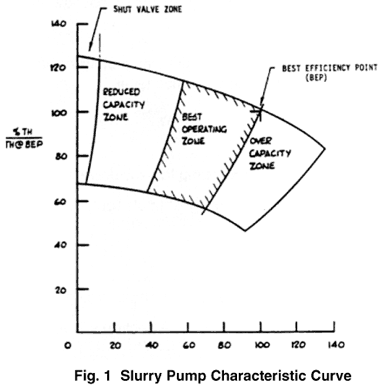
The velocities within the pump are usually very high and recirculation occurs causing excessive wear. The radial hydraulic loads on the impeller increase.
Recommended Operation Zone:
The velocities within the pump are reduced (but not enough to cause settlement). Recirculation is minimal and the flow in the suction nozzle should be axial (no induced vortex). The radial hydraulic loads are minimized.
Reduced capacity Zone:
The velocities within the pump are low, separation and recalculation occurs, causing excessive wear. Reducing the capacity should be limited because a certain minimum velocity must be maintained to avoid settling out; with the consequence of increased wear and clogging. The hydraulic radial loads will increase and the pump efficiency will decrease.
Shut Valve Zone:
This is the point of zero flow, and pump should not be operated at this point for any length of time. Wear and tear will be rapid due to separation and recirculation, the hydraulic forces will be at their highest, and settlement and plugging will occur. The pump will rapidly heat up, which is particularly serious in rubber constructed pumps.
PRINCIPAL WEAR AREAS
As the abrasive mixture passes through the pump, all the wetted surfaces which come in contact will be subject to varying degrees of wear. It is very important to note that the performance of a conventional centrifugal pump, which has been misapplied to a slurry service, will be significantly effected by a relatively small degree of abrasive wear.
The areas most prone to wear, in order of severity, are:
- 1. Suction sideplate, particularly at the nozzle region.
- 2. Impeller, particularly at the eye vane inlets, suction side impeller shroud, and the vane tips.
- 3. Casing cutwater and side walls adjacent to the impeller tip.
- 4. Stuffing box packing and sleeve.
In hard iron pumps applied to severely abrasive service, the relative wear rates of the suction side liner, casing, and impeller are in the order of 3 to 1.5 to 1, e.g. the life of the casing is three times that of a suction side wear plate.
Recognizing that due to the nature of the mixtures being pumped, the complete elimination of wear is impossible, the life of the parts can be appreciably prolonged and the cost of maintenance reduced by a good pump design and selection, e.g.:
- Construct the pump with good abrasion resistant materials.
- Provide generous wear allowances on all parts subject to excessive wear.
- Adopt a hydraulic design which will minimize the effects causing wear.
- Adopt a mechanical design which is suitable for the materials of construction and has ready access to the parts for renewal.
- Limit the head to be generated and select a low speed pump.


